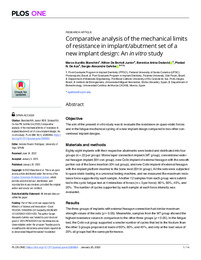Título :
Comparative analysis of the mechanical limits of resistance in implant/abutment set of a new implant design: An in vitro study |
Autor :
Bianchini, Marco Aurélio 
Silva Junior, José Nilton da 
Dedavid, Berenice Anina 
De Aza, Piedad 
Gehrke, Sergio  |
Editor :
Antonio Riveiro Rodrıguez, |
Departamento:
Departamentos de la UMH::Ciencia de Materiales, Óptica y Tecnología Electrónica |
Fecha de publicación:
2023-01 |
URI :
https://hdl.handle.net/11000/29193 |
Resumen :
Objective: The aim of the present in vitro study was to evaluate the resistance on quasi-static forces and in the fatigue mechanical cycling of a new implant design compared to two other conventional implant designs.
Materials and methods: Eighty-eight implants with their respective abutments were tested and distributed into four groups (n = 22 per group): Morse taper connection implant (MT group), conventional external hexagon implant (EH con group), new Collo implant of external hexagon with the smooth portion out of the bone insertion (EH out group), and new Collo implant of external hexagon with the implant platform inserted to the bone level (EH bl group). All the sets were subjected to quasi-static loading in a universal testing machine, and we measured the maximum resistance force supported by each sample. Another 12 samples from each group were submitted to the cyclic fatigue test at 4 intensities of forces (n = 3 per force): 80%, 60%, 40%, and 20%. The number of cycles supported by each sample at each force intensity was
evaluated. Results: The three groups of implants with external hexagon connection had similar maximum strength values of the sets (p > 0.05). Meanwhile, samples from the MT group showed the highest resistance values in comparison to the other three groups (p < 0.05). In the fatigue test, the Collo out group supported a smaller number of cycles that led to the fracture than the other 3 groups proposed at loads of 80%, 60%, and 40%, and only at the load value of 20% all groups had the same performance.
Conclusions: Within the limitations of the present in vitro study, the results showed that the new Collo implant performs better when installed at bone level.
|
Palabras clave/Materias:
implant design
conventional implant designs
resistance on quasi-static forces |
Área de conocimiento :
CDU: Ciencias aplicadas: Ingeniería. Tecnología |
Tipo de documento :
info:eu-repo/semantics/article |
Derechos de acceso:
info:eu-repo/semantics/openAccess |
DOI :
https://doi.org/10.1371/journal.pone.0280684 |
Publicado en:
Plos One |
Nombre Congreso:
Grant PID2020-116693RB-C21 funded by MCIN/AEI/ 10.13039/501100011033 |
Aparece en las colecciones:
Artículos - Ciencia de los materiales, óptica y tecnología electrónica
|
 La licencia se describe como: Atribución-NonComercial-NoDerivada 4.0 Internacional.
La licencia se describe como: Atribución-NonComercial-NoDerivada 4.0 Internacional.
.png)
